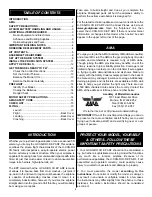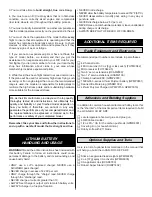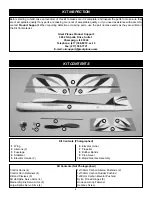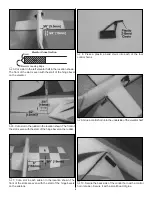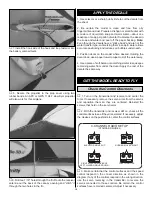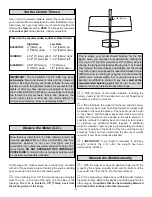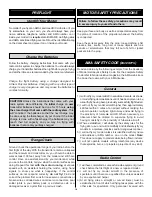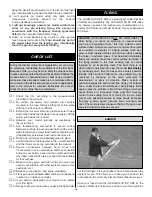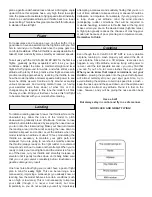
plane a gentle underhanded toss at about a 30-degree angle
upward. Since this airplane has a very high thrust to weight
ratio, the plane will accelerate to flying speed almost instantly.
Climb to a comfortable altitude and throttle back to a lower
power setting. This plane flies great at about half-throttle when
in standard forward flight.
For reassurance and to keep an eye on other traffic, it is a
good idea to have an assistant on the flight line with you. Tell
him to remind you to throttle back once the plane gets to a
comfortable altitude. While full throttle is usually desirable for
takeoff, most models fly more smoothly at reduced speeds.
Take it easy with the U-CAN-DO 3D EP ARF for the first few
flights, gradually getting acquainted with it as you gain
confidence. Adjust the trims to maintain straight and level
flight. After flying around for a while, and while still at a safe
altitude with plenty of fuel, practice slow flight and execute
practice landing approaches by reducing the throttle to see
how the model handles at slower speeds. Add power to see
how she climbs as well. Continue to fly around, executing
various maneuvers and making mental notes (or having
your assistant write them down) of what trim or C.G.
changes may be required to fine tune the model so it flies
the way you like. Mind your fuel level, but use this first flight
to become familiar with your model before landing.
To initiate a landing approach, lower the throttle while on the
downwind leg. Allow the nose of the model to pitch
downward to gradually bleed off altitude. Continue to lose
altitude, but maintain airspeed by keeping the nose down as
you turn onto the crosswind leg. Make your final turn toward
the landing area (into the wind) keeping the nose down to
maintain airspeed and control. Level the attitude when the
model reaches an altitude of about 10 feet, modulating the
throttle as necessary to maintain your glide path and
airspeed. If you are going to overshoot, smoothly advance
the throttle (always ready on the right rudder to counteract
torque) and climb out to make another attempt. When you’re
ready to make your landing flare and the model is a foot or
so off the deck, cut your throttle and smoothly increase up
elevator until it gently touches down on its belly.
Make sure
that you cut your power completely before touchdown, or
gearbox damage may result.
One final note about flying your model: have a goal or flight
plan in mind for every flight. This can be learning a new
maneuver(s), improving a maneuver(s) you already know, or
learning how the model behaves in certain conditions (such
as on high or low rates). This is not necessarily to improve
your skills (
though it is never a bad idea!), but more
importantly so you do not surprise yourself by impulsively
attempting a maneuver and suddenly finding that you’ve run
out of time, altitude or airspeed. Every maneuver should be
deliberate, not impulsive. For example, if you’re going to do
a loop, check your altitude, mind the wind direction
(anticipating rudder corrections that will be required to
maintain heading), remember to throttle back at the top, and
make certain you are on the desired rates (high/low rates).
A flight plan greatly reduces the chances of crashing your
model just because of poor planning and impulsive moves.
Remember to think.
Even though the U-Can-Do 3D EP ARF is a very durable
airplane, learning to crash properly will extend the life of
your airplane. Since this is a 3D airplane, recoveries can
happen in very little altitude, so keep trying with power to
recover until the last possible second – you may find that
you can “fly out” of a lot more crashes than you thought.
When you do know that impact is imminent,
cut your
throttle – plowing the propeller into the ground at full power
will almost certainly strip out your spur gear. Also, try to
avoid allowing the airplane to build up speed into a crash –
keep the nose up and the speed down, and the airplane will
take impact in almost any attitude. Pound it in fast on the
nose, however, and you’ll be gluing the nose section back
on.
Have a ball!
But always stay in control and fly in a safe manner.
GOOD LUCK AND GREAT FLYING!
Crashing
Landing
Flight

